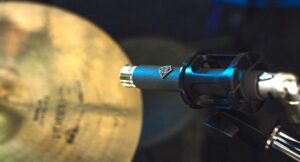10 Cymbal Microphones
There are two main ways to look at cymbal microphones, either use a or an SM57. Either option is acceptable, but there are few other instrument microphones that I have seen, other than the SM57.
As for pencil condensers, there are many that would do the job well: The budget option might be sE Electronics sE7, coming in at $100 USD. The Shure KSM137 at $300 USD would be a recommended option, and is the standard in many studios. Beyond $1000 USD you are paying for the branding in the live setting.
There it no one way to mic a cymbal. I like to have them underneath, pointing upward at the mid point of the cymbal:


I think this gives a good sound, and doesn’t get in the way of the drummer or any of the cymbals. This is of particular importance for a live setting. I have been in the midst of a show and there is the wonderful sound of the drummer or cymbal smacking the head of an SM57. There is nothing like that to make you cringe and desire to get a different position.
There are other schools of thought. Telefunken shows how many like to place it on the exact opposite side:

The reason this is popular is because it shields the microphone, assume it is a , from other sounds. The microphone will reject the sound from the sides and behind. I don’t mind the bleed from some other cymbals in this case for two reasons: One, I put a on the channel. Two, because in this scenario with these drum sets I didn’t find much bleed to occur in the first place.
The best way to determine how to mic the cymbals is to experiment. Trial and error is the best and only way to determine how you want to mic your cymbals with your microphones.
A type of condenser microphone that is long and skinny, a shape similar to a pencil. They are also called Small Diaphragm Condensers.
A shape of polar pattern that is roughly shaped like a heart when looking at the capsule from above.
The directions the the microphone is sensitive to in a polar graph around the center of the diaphragm while looking from above.
a dynamic effect that can be put on an input to limit when that channel is "open" or audio flows through. If it is under a certain audio level, the gate will "close" the channel and not allow audio to pass through.

